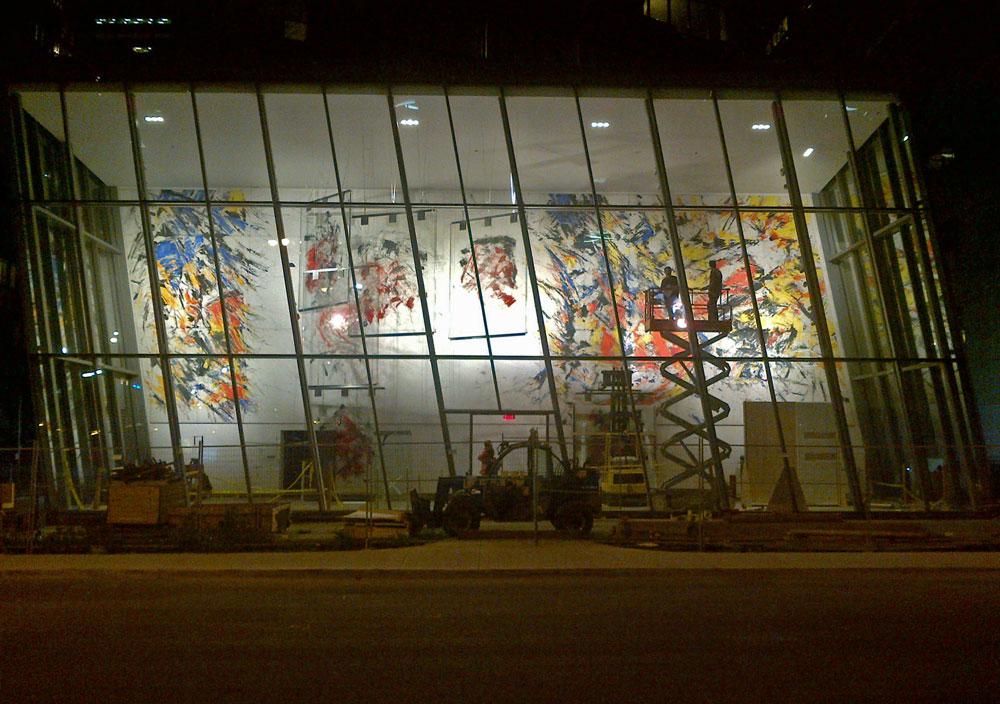In the movie The Decameron, director Pier Paolo Pasolini impersonates a pupil of Giotto who is about to paint a fresco in a church. He knows that the fresco presents a couple of challenges: quick decisions, and an even quicker execution. Once he has dreamed a vision of the Virgin Mary, he doesn’t stop to eat, and he doesn’t hesitate; he is devoured by a feverish haste to paint his dream.
Indeed, even when it comes to contemporary fresco work, “there’s no rethinking,” says Sandro Martini, the Italian artist responsible for a new, enormous, abstract fresco in the atrium of Toronto’s Burano condominium building. “Once you begin working, you must continue. There’s only a few hours available to complete an image, and the technique doesn’t permit mistakes.”
These are rigorous conditions, and not everyone can meet them. A talent no less than Leonardo da Vinci fell into the arms of temptation by using tempera in an attempt to gain more procedural flexibility from the form, and, as a result, legions of restorers have been employed to save his Last Supper fresco, which is ultimately destined to fade away like the memory of a dream.
Sandro Martini is a minute man, a frail-seeming person who becomes a titan once he takes the helm of the scaffolds, which he climbs with the enthusiasm and carelessness of an experienced sailor. Once on top in Toronto during the August installation of the project, he called his men to work. They did their best to understand his foreign orders—foreign not necessarily to English speakers, but to a New World mentality scarcely used to fresco.
Observing this cultural chasm, Martini explained that there are not many artists who have applied the old Renaissance technique of the fresco since the advent of conceptual art.
Martini’s career has spanned five decades in Italy and the United States. His visit to Canada came via a commission by Lanterra, a development company that in the past has worked with Vito Acconci, among other artists, to bring creative acumen to its Toronto-area condominium projects.
The nature of the project meant that Martini faced challenges that were even, perhaps, a bit more daunting than those of Giotto’s filmic pupil. After the latter has his dream sequence, he runs directly to the scaffolds, groups all his workers and, in a few short moments, gives life to his vision: the Virgin Mary surrounded by an adoring crowd. Martini’s process was, by contrast and by necessity, considerably more drawn out. In his Milan studio, he painted 30 panels and etched 6 glass sheets, in total weighing hundreds of kilograms. He couldn’t see the whole work until he came to Toronto, where he assembled and completed the 28-metre-by-8-metre project.
However, Sandro Martini, like Giotto’s pupil, did dream of the work that he would carry out. He saw it in his mind. And most likely, as in the film, he asked himself the same question that the protagonist whispers: “Why realize a work of art when it is so nice simply to dream it?”
We should be grateful Martini went forward; his work at Burano, now viewable via a public right-of-way, is absolutely breathtaking. The eye uncovers a landscape cracked by lines and lightning. Two walls flank a space lying fallow—a place where the colours surrender, where the mind ceases to fight.
Sandro Martini’s work is an outstanding contribution to a city of the future using a technique of the past.









